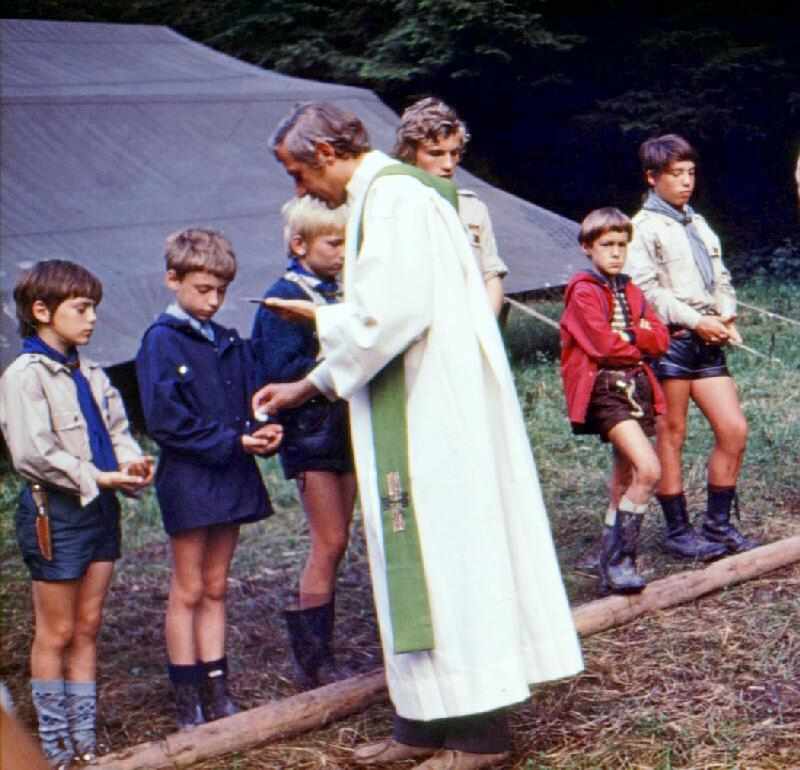
Figure 1.--Here we see a priest giving communion to Catholic Scouts probably in the late 1960s. The photo cannot have been taken earlier. Before 2nd Vatican Council (1962-1965), Communion was given in the mouth and the communicants were kneeling. |

|
One of the dividing line between German Scouts has been religion. While the Wandervogel movement was a non-denominational Christian groups (Jews were often excluded), many Scouts groups were organized on a religious basis. The Cathlolic Scouts often insisted on a separate group. This was not the case in America where there is only one association. The organization of Scout troops around churches and schools, however, often meant that Catholic Scouts were in separate troops. The Protestants were less concerned about separate groups, but we notice a Baptist association. These assocviations were members of the German Youth Associastion until taken over by the NAZIs (1933). The Catholic youth associsations were allowed a few more yearts of independent existence. After World war II, SDcouting was reestablisdhed. The Scouting movement is the Ring deutscher Pfadfinderverbände which includes Catholic and other associations.
HBU knows little about Catholic Scouting at this time. The Catholic Church all over Europe was at first deeply suspicious about Boy Scouting. Scouting grew out of the Protestant Boys' Brigade movement. And coming from Protestant Britain was anoher problem. The movement proved so populsar, however, thsat the Church could not inore it. So in the countries of Continental Europe with Catholic populations, the Church insisted on sepsrate Catholic associations. And often there were multiple associations. We do not have aot of detail about the specific German associations. One Catholic associsation was the Deutsche Pfadfinderschaft Sankt Georg (DPSG) founded (1929). The four sections are called Wölflinge, Jungpfadfinder, Pfadfinder and Rover. The leaders are called Leiter and Leiterinnen. The organisation is divided into Diözesen – the Catholic Diocese areas, eg. the Diözese Mainz. When the HJ seized control of the German Youth movement (1933), the NAZIs for as allowed the Catholic groups to continue functionoing. Hitler was cautious at first, not wanting to generate opposition among German Catholics while he was consolidating power..
The principal Protestant denomintion in Germany is Luterenism. The Baptisrts are a elsatively small group. Baptist Scouting began in the rather inoportune year of 1932, with Karl August Hahne. He was a preacher in Gelsenkirchen and was so impressed by the Scouting movement developed since 1908 in England that he created the Baptist Scouts Union in his town and appointed Erich vom Bovert to lead the Union--"VCJcM
EICHENKREUZARBEIT". The uniform consisted of a green shirt, a yellow scarf, belt and shoulder belt. After only 2 years the NAZIs put a sudden end to the new Baptist Scout Union. The entire German Scout movement was integrated by law into the Hitler Youth. The Baptist Scouts operated secretely until the outbreak of World War II (1939-45) made cladestine Scouting impossible. The Baptist Scouts were resestablished after the War.
Germany had the strongest youth movement in Europe in the early 20th century before the appearance of Scouting. The Jewish youth movements which developed in in central and eastern Europe (such as Blau-Weiss) were influenced more by the German Wandervögel movement than by the British scouting movement. This is in part a function of the level of assimilsation in Germany. There was a separate Scout asspciation for Jewish Scouts. Some of the boys preferred a separate organization, but Jewish boys were not welcome in many Scout groups. (The same had been true for Wandervogel.) Jewish scouts from all over Europe met in France to cross Europe came to France to participate in the first international Jewish scout camp (1931). The participants agreed to establish a World Union of Jewish Scouting. They were, however, unable to organize after Hitler and the NAZIs seized control of Germany (1933). We do not yet know whsat happened to Jewish youth groups when the HJ seized control of the German Youth Movemnent. We believe thy were ast first allowed to operate, but their property was seized. And they along with other Jewish organizations were banned. After World War II, whe n Scouting was reserected, there were to few Jewish boys left in German for a separate Scout association.
Navigate the Historic Boys' Uniform Chronology Pages:
[Return to the Main chronologies page]
[The 1900s]
[The 1910s]
[The 1920s]
[The 1930s]
[The 1940s]
[The 1950s]
[The 1960s]
[The 1970s]
[The 1980s]
[The 1990s]
[The 2000s]
Navigate the Historic Boys' Uniform Web Site:
[Introduction]
[Activities]
[Biography]
[Chronologies]
[Countries]
[Essays]
[Garments]
[Organizations]
[Other]
[Bibliographies]
[Contributions]
[FAQs]
[Questions]
[Unknown images]
[Boys' Uniform Home]
Navigate the Historic Boys' Uniform Web organization pages:
[Return to the Main German Scout page]
[Return to the Main German page]
[Boys' Brigade]
[Camp Fire]
[Hitler Youth]
[National]
[Pioneers]
[Royal Rangers]
[Scout]
